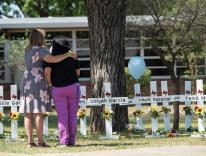
Some time ago I made plans for my death, also called Preneed Funeral Planning. My “advanced planning counselor” and I sat down over a cup of tea in my dining room and began to discuss the inevitable. This was shortly after I had had a heart bypass operation, so I must have felt more than ever before intimations of mortality. I know I wasn’t feeling as desperate as Melville’s Ishmael: “Whenever I find myself involuntarily pausing before coffin warehouses, and bringing up the rear of every funeral I meet...then, I account it high time to get to sea as soon as I can.” But for the first time in my life I must have glimpsed a black ship on the horizon and guessed it was time to begin arranging my steamer trunk.
“Why are you doing this now?” my advanced planning counselor asked me after I had signed the contract.
I thought that was obvious, yet I was at a loss for words. Faced with my silence, he helped me along.
“You probably want to spare others at a difficult time.”
In fact, I had been thinking that I really was sparing myself at a difficult time. On reflection, of course, I realized that this was silly—I would not be there for any “difficulties.”
“Yes, of course,” I said, though to be honest I had also been influenced by the fact that, if what I had heard was true, I would be saving money. Hadn’t I read somewhere that funeral costs were on the rise and that they were going to keep rising? Another silly thought, under the circumstances. Or had I believed you really can take it with you?
I filed the contract away and went on with living, thanks to statins, aspirin, and exercise. (“Walk, walk, walk,” my heart surgeon had told me.) Recently, however, I took the contract out and reread it—the result of coming across a copy of Sir Thomas Browne’s Urn Burial. According to the contract, I had chosen a corrugated paperboard casket in which to be cremated and a $60 urn for the ashes. According to Sir Thomas Browne, this thing we call our earthly vessel is a profoundly complex and entertaining artifact. Our brains, which he describes, borrowing from Hippocrates, as “the Metropolis of humidity,” may help our skulls burn less than other bones, and “some bones make but Skeletons, some bodies quick and speediest ashes.”
It was Browne’s philosophical thoughts, however, that I found especially interesting. “If we begin to die when we live, and long life be but a prolongation of death; our life is a sad composition; we live with death, and die not in a moment.” Or: “But the long habit of living indisposeth us for dying.... But many are too early old, and before the date of age.” And then he nicely puts the final nail in the coffin: “And who had not rather been the good theef, then Pilate?” (Any seventeenth-century book written by an English doctor who practiced “physic” will have its odd moments of spelling and punctuation, especially one whose full title is Hydriotaphia, Urne-Buriall, Or, A Brief Discourse of the Sepulchrall Urnes Lately Found in Norfolk.)
Reading Urn Burial reminded me of the death of the Spanish poet and mystic, St. John of the Cross. After he died in 1591, devotion to him was so great that by the time his body reached Segovia for burial a leg had been left in one city, an arm went missing in Madrid, and a number of fingers were unaccounted for. Most of us are happily exempt from sainthood, so we don’t have to worry about our toes ending up in Toledo, but we all know that quotation about the best-laid plans. How confident should we be?
We moderns pay advanced planning counselors to avoid the fate of St. John of the Cross and to get us to our burial on time, but can we ever be sure it will work out as planned? A recent newspaper article on the rising popularity of cremation reported that some families don’t know what to do with ashes, or don’t have the money to deal with them. Here in Illinois, a funeral home near Chicago took it upon itself to bury 118 unclaimed remains that a county coroner’s office had on its shelves. Sir Thomas Browne’s own skull, after being dug up in 1840 (he died in 1689), was on display in a bell jar in a hospital museum until 1921, when it was reburied in a grave in his Norwich parish, attractively named St. Peter Mancroft.
My own final resting place, I am hoping, will be about a hundred fifty paces from the grave of James T. Farrell, an unexpected presence I welcome, but I did wonder for a while why the creator of Studs Lonigan from the South Side of Chicago ended up in a suburban Catholic cemetery. (The answer, in brief, is a beloved grandmother.) Perhaps we should take to heart Sir Thomas Browne’s own words, prophetic for him and maybe just as prophetic for us: “Who knows the fate of his bones, or how often he is to be buried?” Maybe we just have to have faith.
Please email comments to [email protected] and join the conversation on our Facebook page.
Previous Story
The ACLU Takes on the Bishops
Next Story
Inequality, Religion and the Limits of Civil Society

